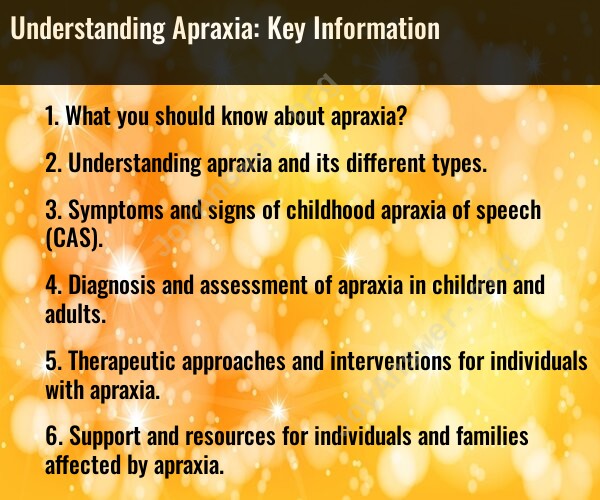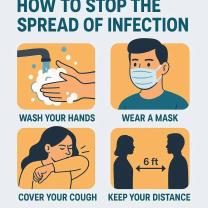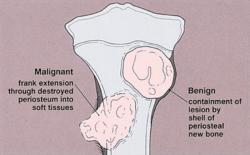What you should know about apraxia?
Apraxia is a neurological condition that affects a person's ability to plan and execute purposeful movements, especially those involving fine motor skills. There are different types of apraxia, but the most common types include ideomotor apraxia and ideational apraxia. Here's some key information you should know about apraxia:
Definition:
- Apraxia is a motor disorder that disrupts the brain's ability to coordinate muscle movements, making it difficult for individuals to perform specific tasks or actions, even though their muscles and physical abilities are intact.
Types of Apraxia:
- Ideomotor Apraxia: This type of apraxia involves a person's inability to imitate gestures or perform actions on command, even if they understand the task and have the physical capability to do so.
- Ideational Apraxia: Individuals with ideational apraxia have difficulty conceptualizing the sequence of movements required to complete a complex task, such as making a sandwich.
Causes:
- Apraxia can result from various causes, including brain injuries, strokes, degenerative neurological conditions like Alzheimer's disease, or other brain disorders. It can also be present from birth in some cases.
Symptoms:
- Common symptoms of apraxia include difficulty with tasks like buttoning a shirt, using utensils, or waving goodbye. People with apraxia may have trouble planning and coordinating the movements necessary for these activities.
Diagnosis:
- Diagnosing apraxia typically involves a thorough evaluation by a neurologist or speech-language pathologist. This may include assessments of motor skills, language abilities, and other cognitive functions.
Treatment:
- While there is no cure for apraxia, various therapies can help individuals manage the condition. These may include speech therapy, physical therapy, or occupational therapy, depending on the specific needs of the person.
Prognosis:
- The prognosis for individuals with apraxia varies depending on the underlying cause, the type of apraxia, and the effectiveness of treatment. Some people may see significant improvement with therapy, while others may continue to experience challenges in performing everyday tasks.
Communication Challenges:
- Apraxia can affect not only motor movements but also speech. Apraxia of speech is a related condition in which individuals struggle to plan and coordinate the precise movements necessary for spoken language. It can result in speech that is slow, inaccurate, and difficult to understand.
Living with Apraxia:
- Individuals with apraxia may require a supportive and understanding environment. Patience and encouragement are essential for those living with this condition, as everyday tasks can be frustrating and challenging.
Research and Support:
- Researchers continue to study apraxia to better understand its causes and to develop more effective treatments. Support groups and organizations are also available to help individuals and their families cope with the challenges of living with apraxia.
Apraxia can have a significant impact on a person's daily life, but with the right support and therapy, many individuals can improve their ability to perform tasks and communicate effectively. Early diagnosis and intervention are crucial for managing the condition and improving the quality of life for those affected by it.
Understanding apraxia and its different types
Apraxia is a neurological disorder that affects a person's ability to plan and coordinate movements. It is not a muscle weakness or paralysis, but rather a difficulty with knowing how to move and when to move. Apraxia can affect any part of the body, including the limbs, face, mouth, and tongue.
There are several different types of apraxia, each of which affects different movements. Some of the most common types of apraxia include:
- Ideomotor apraxia: Difficulty performing skilled movements on command.
- Ideational apraxia: Difficulty understanding and carrying out a sequence of actions.
- Buccal apraxia: Difficulty with movements of the mouth and tongue.
- Limb-kinetic apraxia: Difficulty with movements of the limbs.
- Constructional apraxia: Difficulty with assembling or constructing objects.
Symptoms and signs of childhood apraxia of speech (CAS)
Childhood apraxia of speech (CAS) is a type of apraxia that affects a child's ability to plan and coordinate the movements necessary for speech. CAS is the most common cause of childhood speech disorders.
Symptoms of CAS can vary from child to child, but some of the most common symptoms include:
- Difficulty producing speech sounds correctly
- Difficulty imitating speech sounds
- Difficulty planning and sequencing speech sounds
- Pauses and hesitations during speech
- Difficulty with prosody (the rhythm and melody of speech)
Children with CAS may also have other developmental delays, such as language delays, motor delays, and feeding difficulties.
Diagnosis and assessment of apraxia in children and adults
Apraxia is diagnosed by a speech-language pathologist or neurologist. The diagnosis is based on a physical examination, a speech and language assessment, and medical history.
The speech and language assessment will include tasks such as imitating speech sounds, repeating words and sentences, and naming objects. The assessment will also look at the child's overall speech development and language skills.
The speech-language pathologist or neurologist may also order medical tests, such as an MRI or CT scan, to rule out other medical conditions that could be causing the symptoms.
Therapeutic approaches and interventions for individuals with apraxia
There is no cure for apraxia, but there are therapeutic approaches and interventions that can help individuals with apraxia improve their skills. The goal of therapy is to help people with apraxia learn to plan and coordinate their movements more effectively.
Some of the most common therapeutic approaches and interventions for apraxia include:
- Speech therapy: Speech therapy can help individuals with apraxia learn to produce speech sounds correctly and to plan and sequence speech sounds.
- Language therapy: Language therapy can help individuals with apraxia improve their language skills, such as comprehension, expression, and vocabulary.
- Motor therapy: Motor therapy can help individuals with apraxia improve their overall coordination and motor skills.
Support and resources for individuals and families affected by apraxia
There are a number of support and resources available for individuals and families affected by apraxia. Some of these resources include:
- The Apraxia Kids website: This website provides information and resources for families of children with CAS.
- The American Speech-Language-Hearing Association (ASHA) website: This website provides information about apraxia and other speech and language disorders.
- The National Apraxia Association website: This website provides information and resources for individuals and families affected by apraxia of speech.
In addition to these websites, there are also many local support groups and organizations that can provide support and resources for individuals and families affected by apraxia.













